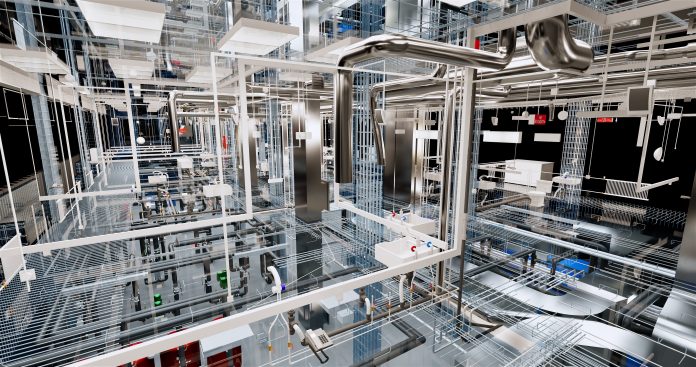Although digital twinning is not new, only as recently as 2017 have digital twins become one of the top strategic technology trends. The growth of the Internet of Things has been a key factor in making digital twins cost-effective, turning them into one of the most exciting areas of change in the built environment today. So, what exactly is the digital twin?
The digital twin is a virtual replica of a real-world object or system across its lifecycle. In the building space, you may look at digital twins as a natural evolution of Building Information Modelling (BIM), which digitally represents the ‘as-built’ environment. BIM constitutes the foundation for the creation of a real estate digital twin.
Mainly because of the explosion of real-time sensor data, BIM models can now become dynamic, up-to-date twins that mimic the real-world behaviour of buildings over their lifetime. This is not limited to physical factors but extends to the modelling of occupancy and utilisation, occupant experience, economic efficiency, ecological impact and the relation to other built objects in an infrastructure system. As the data grows in volume and complexity, data science and AI are becoming increasingly important to connect and interpret it.
Different people mean different things when talking about the digital twin. This is because digital twins also exist on a maturity curve: from the basic to the smart, to the autonomous. Let’s look at some key use cases and benefits across three levels of sophistication.
-
The Basic Twin: A detailed digital copy
As early as the 1960s, Nasa created physical copies of spacecraft at ground level to match systems in space and be able to simulate and resolve issues remotely. A basic digital twin is similar, but today these copies are virtual rather than physical. Updated over time, they provide reliable spatial and asset data that can be remotely accessed.
These twins – often used in the context of building maintenance and operations – enhance productivity and save time spent looking up key information. They improve governance of assets, reduce failure costs and enable better-informed decision-making.
2. Smart Twin: Updated with real-time inputs
By today’s standards, the digital twin has a (near) real-time connection to its physical twin. Changes in the physical twin are reflected in the digital model, typically through extensive use of IoT devices and sensors. This greatly enhances responsiveness, which in turn drives productivity improvements.
This type of twin usually has a greater focus on improving the built environment for its users. Leveraging more granular and richer data sets for analytics and simulations, the smart twin allows to optimise the user experience, while also improving energy efficiency and reducing space requirements. Depending on the building location and type of lease, this can represent enormous cost savings for tenants.
In the post-pandemic world, many office workers will not return to their desks full-time. This means that firms will need less square footage and commercial real estate will have to fight harder to attract and retain clients. To market themselves to end-users and tenants (and thereby generate value for investors and owners), buildings will need to become more responsive. By leveraging live data from a smart twin, they can position themselves favourably in an increasingly competitive market.
3. Autonomous Twin: Bidirectional effects
In an autonomous twin, the digital-physical link is bidirectional, meaning that the digital twin can produce changes in the physical object, with those changes registering back in the virtual copy. For example, the twin registers that a temperature threshold is exceeded, it triggers the HVAC system, the space cools down, the model shows cooler temperatures, and the HVAC is instructed to maintain the temperature. The digital twin and its physical counterpart operate in a seamless way to keep the building comfortable for occupants. Enhanced with AI, bidirectional twins will be able to generate fully autonomous buildings that provide optimal conditions for their occupants.
“The low-hanging fruit for real estate digital twins for the moment is largely in predictive maintenance and energy efficiency,” states Wouter Hartemink, CRO of Spacewell, a Nemetschek Group brand. “Over time, though, I believe the real value of real estate digital twins will be in elevating the occupant experience.”
Autonomous digital twins – with the help of self-learning algorithms and myriad data points – will become increasingly better at predicting what occupants want and will automate this optimal situation by default. Personalised environments and recommendations will further enhance the experience.
“Tech companies such as Google, Amazon and Spotify have already learned that personalised products are more successful than generic products,” Hartemink adds. “In time, smart digital twins will drive more personalised experiences in buildings too.”
Digital twins are also likely to become valuable assets in their own right. The building lifecycle intelligence from digital twins is going to be incredibly useful to building owners and operators, as well as to architects, planners and construction companies in other stages of the building lifecycle. For example, the utilisation data of buildings can be used by designers and architects to improve their designs, based on insight into how the building is used over time (and not on how they imagined it would be used). This creates a positive feedback loop in which best outcomes can be used as inputs for (parametrical) design. A deeper dive is provided by this Spacewell white paper.
Alexander Siegmund
Manager Corporate Communication & PR
Nemetschek SE
Tel: +49 89 540 459 255
Please note: this is a commercial profile.














